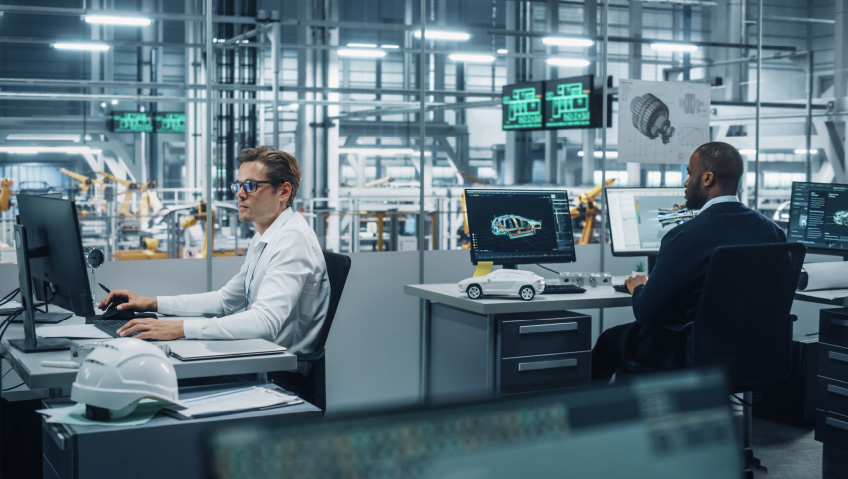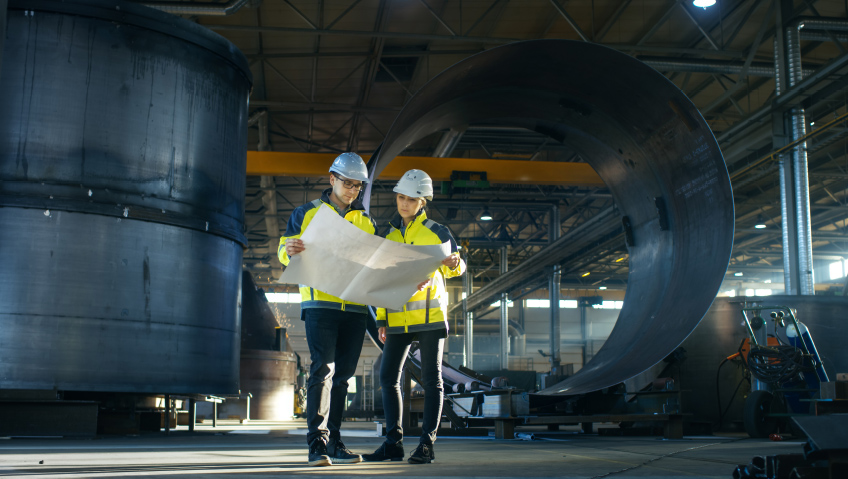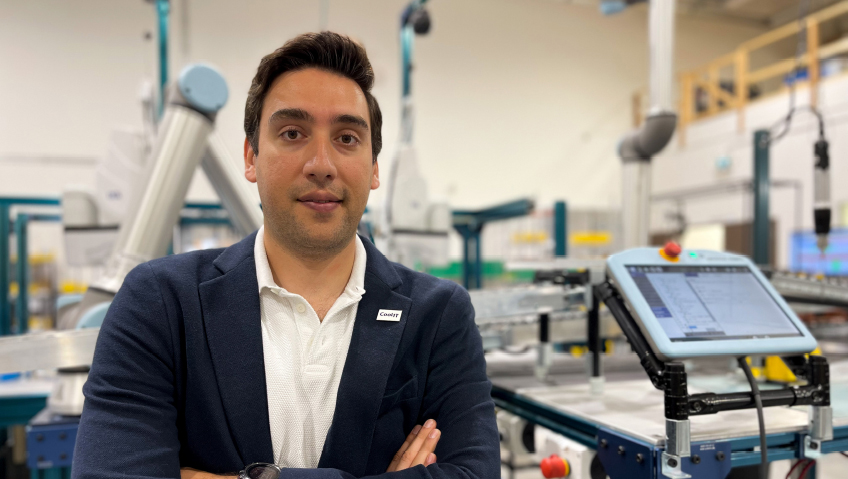Like many businesses today, yours may be wrestling with the realities of automation, sustainability, supply chain management, and a rapidly increasing choice of new materials and their promises to improve product development and deliver higher profits.
How to chart the best course for company improvements? It starts with understanding the emerging tech and where it can take you.
The one that’s gaining wide adoption right now is automation, a key driver for achieving reductions in resources and energy requirements. Automation can also generate robust volumes of data that can be applied to manage efficiencies in terms of raw materials, inputs and labor.
In fact, automation in manufacturing has been likened to the technologies available in today’s cars.
Business owners and management, much like drivers, need to decide what level of automation and technology they are most comfortable with. Is it a self-driving car or maybe adaptive cruise control? Or for the more hands-on individuals, it could be the time trusted standard transmission?
Whatever your preference, things are changing, and the impact will be profound.
Operation 2030
The World Economic Forum has created a program called Operation 2030. The objective is to lead emerging markets toward the United Nation’s sustainable development goals which focus on combating climate change, poverty and hunger. To reach these goals and the timeframe of these initiatives, the Forum revealed a $10 trillion investment program.
To provide perspective, $10 trillion is a sum larger than the size of all but two of the world’s economies.
The chasm between the simple pursuit of profits and profit-centric organizational efficiencies, developed by using fewer inputs and reducing carbon footprints, has begun to close. Modest reductions in electricity, heat, and water consumption can improve financial performance while at the same time boosting consumer and corporate relations.
And now corporate leadership is asking how to make products more sustainable and use less water and energy.
Going green has long been established as sound business practice but the UN’s sustainable development goals have made it clear that a focus on responsible corporate sustainability will guide capital spending for years to come.
On the other hand, many of the U.S. manufacturing facilities are aged, some more than 50 years old. Most have focused on operations and have predominantly designated capital resources for technology that can squeeze more profits by being more efficient.
No question, there are significant areas of improvement for manufacturers to progress on their green journey – most are still in the early stages and have set only modest targets.
Going big
The unavoidable upshot is that businesses must now begin to look at large investments to stay in the game. Changes in consumer demand, government policies, and corporate purchasing decisions are becoming fundamental to how businesses conduct their operations. Consumers are willing to pay premiums for sustainable products and this, combined with organizational procurement requirements for vendors, is pushing businesses to align with more sustainability.
The International Chamber of Commerce and leading business organizations issued a statement following a recent sustainability forum: “The sustainable development goals provide all businesses with a new lens through which to translate the world’s needs and ambitions into business solutions.
“These solutions will enable companies to better manage their risks, anticipate consumer demand, build positions in growth markets, secure access to needed resources, and strengthen their supply chains, while moving the world towards a sustainable and inclusive development path.”
Microsoft is one such company working to reduce its footprint while also helping other companies to be more efficient. The global tech giant has increased access to serverless, open-source software that reduces the need for ventilation, cooling, and even air conditioning, in large data centers.
Microsoft has also teamed up with Danish-based Orsted which owns and operates 1,000 offshore wind turbines. In 2020, Orsted was named the world’s most sustainable company. Microsoft’s advanced predictive software is embedded in Orsted’s turbines and is part of that company’s sustainable digital strategy.
As we know, the pandemic put the world in a tailspin, but the manufacturing reset has been remarkable. Consider the challenges of supply chain management and doing things in new ways.
Supersizing the supply chain
As Peter Georgacopoulos, a Canadian supply chain analytics guru, says, “I look at numbers differently from how a lot of people look at them. I don’t look at them from a finance perspective. I look at what the customer is trying to tell us. If you can get down to looking at a specific customer and what their needs are, that’s gold.”
Supply chain 4.0 will witness the use of robotics, sensors, and networks to automate and analyze everything, everywhere, and vastly improve performance and customer satisfaction while mining a treasure trove of data.
Essentially, supply chain and logistics have gone from an operational function reporting to sales or manufacturing about the supply of production line materials or customer deliveries, to an independent function focused on analytics and advanced planning.
These digital supply chains allow companies to address the needs of their customers, and also predict and address supply side issues and efficiencies. This predictive forecasting takes into account myriad data sets, including school vacation periods and weather and machine spare parts inventories, all the while overlaying a precise forecast of customer demand.
These forecasts are no longer quarterly or monthly, but daily, and in some instances predictive – predicting what customers will order based on past behavior.
The American faucet manufacturer Moen, as an example, has a structured methodology for modeling a variety of scenarios to support its operational activities. The company can predict its inventory and optimize product placement at retailers.
The focus on supply chain has led to new business models, like the “Uberization” of transport capacity. This provides more agility in distribution networks and keeps costs in check. Other new transport concepts such as drone delivery are also being used to expedite delivery in the last mile of the supply chain.
All of this is augmented with next-gen performance management systems providing real-time, door-to-door transparency throughout the supply chain. Information available through these management systems includes delivery service levels and real-time location of delivery vehicles – info that’s transparent and available to all partners in the supply chain.
New Materials, New Vistas
And what about exciting new materials in the industry?
The Materials Genome Initiative announced by President Obama in 2011 is just beginning to transform our world as scientists – aided by artificial intelligence – create new elements and materials. Obama hoped that this initiative would improve U.S. global competitiveness and could be a key in tackling the global challenges of energy, security and human welfare.
Among the best-known outcomes of this initiative is the ubiquitous lithium-ion, present in everything from smartphones to self-driving cars. The concept for these batteries surfaced in the 1970s but didn’t make it to market reality for 20 years. Over the years, lithium-ion batteries have seen an astounding drop in price while increasing energy-storage capacity eleven-fold.
Producing enough of these cells to meet consumer demand is an issue that is now being addressed. A company that has stepped up to the production challenge is Tesla, one of whose factories in Nevada is producing 20 gigawatts of energy storage annually. One gigawatt is enough energy to power 100 million LED lightbulbs.
CEO Elon Musk estimates that 100 such factories could create enough battery storage for the energy requirements of the entire planet. Others working toward similar capacity are Renault, BMW, Audi, Toyota and Nissan. Lithium-ion storage is considered the key in bringing the cost of wind and solar power into line with gas and oil.
“Solar power [with] batteries will be the primary means of sustainable energy production,” Musk told investors. “Solar power will be the single largest source of electricity generation by the mid-point of the century. People do not understand the magnitude of the business. It’s really very, very significant.”
Graphene is another new material that is changing manufacturing, essentially made from the same graphite as used in pencils. Graphene is a one-atom thick sheet of carbon. Although nearly weightless, it is 200 times stronger than steel and has the capacity to conduct electricity and can dissipate heat faster than any other known material.
In applications like sensors and transistors, graphene helps devices communicate. It has even been used successfully in damaged spinal cords where it helps neurons connect and communicate with the spinal cord. Graphene could also be used in automotive parts, making cars lighter, stronger and more fuel-efficient.
Perovskite goes solar
Another rising star is perovskite, a light-sensitive crystal. Currently, the conversion efficiency of solar panels is about 16 percent, a measure of how much sunlight is converted into electricity. Perovskite use in solar panels has the potential to increase that conversion rate to 66 percent. Put another way, one perovskite panel will have the output of four of today’s panels.
This will significantly reduce the cost of solar power.
These new materials are coalescing to solve even large-scale problems such as climate change. Scientists are working to take carbon dioxide from the atmosphere and convert it into ultra-strong carbon nanofibers. This technology at scale and powered by solar could reduce CO2 in the atmosphere to pre-industrial levels within 10 years.
The takeaway? Manufacturing is on the cusp of change for a better future – and we’ve got the tech to make it happen.






